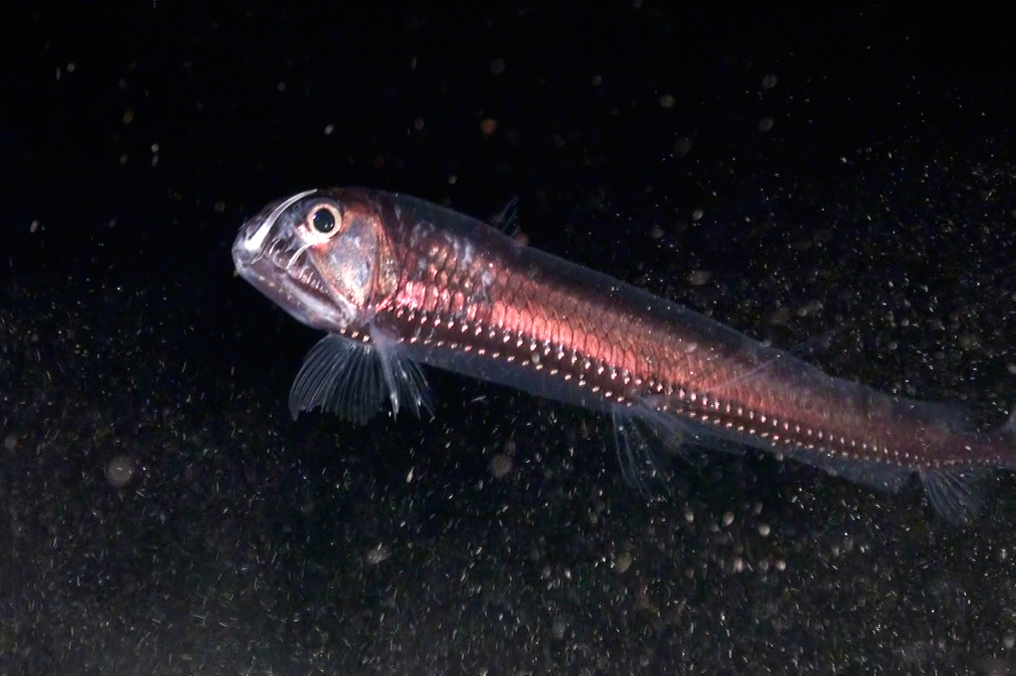Sloane's Viperfish, Chauliodus sloani Bloch & Schneider 1801

Sloane's Viperfish, Chauliodus sloani, photographed by an ROV at Baja de Anacón, El Hierro, Canary Islands, Spain, during the Ranger Expedition to the Atlantic Seamounts, September 2014.. Source: Oceana Europe / Flickr. License: All rights reserved
Video of a viperfish on the Palinuro Seamount off the coast of Sicily, Italy, November 2012.
Sloane's Viperfish, Chauliodus sloani Bloch & Schneider 1801
More Info
|
Distribution |
Occurs off all Australian States except the Northern Territory. Elsewhere the species is found worldwide in tropical and temperate oceans, in depths above 600 m at night, and at 500-2500 m during the day. |
|
Features |
Dorsal fin 7; Anal fin 10-13; Caudal fin 18; Pectoral fin 11-14; Pelvic fin 7. Photophores: IP 9–11; PV 18–21; VAV 24–28; AC 9–13 (IC 63–69); OV 17–21; VAL 24–28, (OA 43–48). Distinctive dragonfishes with extremely elongate fang-like teeth, both dorsal and ventral adipose fin, dorsal fin with short, distinctly elevated base well forward on back, its 1st ray greatly prolonged, nearly half body length in some and tipped with light organs, anal fin close to tail, and slender compressed body covered with 5 rows of hexagonal areas each having one or more small photophores, these areas interpreted as scales by some. Each side of lower jaw with 5–9 fang-like teeth; 4 on either side of premaxillary, each piercing opposing jaw when mouth closed; very small chin barbel in young, reduced or absent in adults; undamaged specimens encased in gelatinous luminescent membrane; pectoral fin of moderate size, close to gill opening; ventral fin elongate, at or in front of mid-body. Body depth 6–12% SL; head length 10–16% SL; eye diameter 2–4% SL; dorsal-fin origin above OV photophore 5–8. |
|
Size |
Reaches 30 cm in length. |
|
Colour |
Iridescent dark silvery-blue with hexagonal pigmented areas and pale fins. |
|
Feeding |
A voracious carnivore, preying mostly on small mesopelagic fishes (especially myctophids) and crustaceans. The light organs on the first dorsal-fin ray may lure prey into the range of the trap-like jaws. |
|
Biology |
Oviparous. The sexes are separate and fertilisation is external; eggs and larvae are pelagic. |
|
Fisheries |
Of no interest to fisheries, although the species is somtimes as bycatch in deepwater trawl fisheries.. |
|
Etymology |
The species is named in honour of British physician and naturalist Hans Sloane, whose 1725 Voyage to Jamaica is cited several times by Bloch and Schneider. |
|
Species Citation |
Chauliodus sloani Bloch & Schneider, 1801, Systema Ichthyologiae: 430. Type locality: Gibraltar, Strait of Gibraltar, western Mediterranean Sea. |
|
Author |
Bray, D.J. 2023 |
|
Resources |
Sloane's Viperfish, Chauliodus sloani Bloch & Schneider 1801
References
Bloch, M.E. & Schneider, J.G. 1801. Systema Ichthyologiae Iconibus ex Illustratum. Berlin 584 pp. 110 pls. See ref at BHL
Bulman, C.M. & Koslow, J.A. 1992. Diet and food consumption of a deep-sea fish, orange roughy Hoplostethus atlanticus (Pisces: Trachichthyidae), off southeastern Australia. Marine Ecology Progress Series 82: 115-129.
Butler, M., Bollens, S.M., Burkhalter, B., Madin, L.P. & Horgan, E. 2001. Mesopelagic fishes of the Arabian Sea: distribution, abundance and diet of Chauliodus pammelas, Chauliodus sloani, Stomias affinis, and Stomias nebulosus. Deep Sea Research Part II: Topical Studies in Oceanography 48(6-7): 1369-1383.
Gibbs, R.H., Jr. 1986. Family No. 67: Stomiidae, Family No. 68: Chauliodontidae, Family No. 69: Astronesthidae, Family No. 72: Melanostomiidae. pp. 229-243 in Smith, M.M. & Heemstra, P.C. (eds) Smith's Sea Fishes. Johannesburg : Macmillan South Africa xx + 1047 pp. 144 pls.
Günther, A. 1864. Catalogue of the Fishes of the British Museum. Catalogue of the Physostomi, containing the families Siluridae, Characinidae, Haplochitonidae, Sternoptychidae, Scopelidae, Stomiatidae in the collection of the British Museum. London : British Museum Vol. 5 455 pp.
Harold, A.S. 1999. Families Gonostomatidae, Sternoptychidae, Phosichthyidae, Astronesthidae, Stomiidae, Chauliodontidae, Melanostomiidae, Idiacanthidae, Malacosteidae. pp. 1896-1917 in Carpenter, K.E. & Niem, V.H. (eds). The Living Marine Resources of the Western Central Pacific. FAO Species Identification Guide for Fisheries Purposes. Rome : FAO Vol. 3 1397-2068 pp.
Harold, A. 2015. Chauliodus sloani. The IUCN Red List of Threatened Species 2015: e.T190324A21909314. http://dx.doi.org/10.2305/IUCN.UK.2015-4.RLTS.T190324A21909314.en. Downloaded on 01 October 2019.
Kenaley, C.P., Harold, A.S. & Gomon, M.F. 2008. Family Stomiidae. pp. 240-254 in Gomon. M.F., Bray, D.J. & Kuiter, R.H (eds). Fishes of Australia's Southern Coast. Sydney : Reed New Holland 928 pp.
McCulloch, A.R. 1916. Report on some fishes obtained by the F.I.S. Endeavour on the coasts of Queensland, New South Wales, Victoria, Tasmania, South and South-Western Australia. Part 4. Biological Results of the Fishing Experiments carried on by the F.I.S. Endeavour 1909-1914 4(4): 169-199 figs 1-2 pls 49-58 (described as Chauliodus dannevigi)
Morrow, J.E. 1961. Taxonomy of the deep sea fishes of the genus Chauliodus. Bulletin of the Museum of Comparative Zoology, Harvard 125(9): 249-294 figs 1-10
Robertson, E.M. & Gomon, M.F. 1994. Families Stomiidae, Chauliodontidae, Astronesthidae, Melanostomiidae, Malacosteidae, Idiacanthidae. pp. 251-263 figs 225-235 in Gomon, M.F., Glover, C.J.M. & Kuiter, R.H (eds). The Fishes of Australia's South Coast. Adelaide : State Printer 992 pp. 810 figs.
Stewart, A.S. 2015. Family Stomiidae, 70 Subfamily Chauliodontinae. pp. 492-493 in Roberts, C.D., Stewart, A.L. & Struthers, C.D. 2015. The Fishes of New Zealand. Wellington : Te Papa Press Vol. 2 pp. 1-576.
Williams, A., Koslow, J., Terauds, A. & Haskard, K. 2001. Feeding ecology of five fishes from the mid-slope micronekton community off southern Tasmania, Australia. Marine Biology139(6): 1177-1192. https://doi.org/10.1007/s002270100671
Young, J.W., Lamb, T.D. & Bradford, R.W. 1996. Distribution and community structure of midwater fishes in relation to the subtropical convergence off eastern Tasmania, Australia. Marine Biology 126(4): 571-584.











